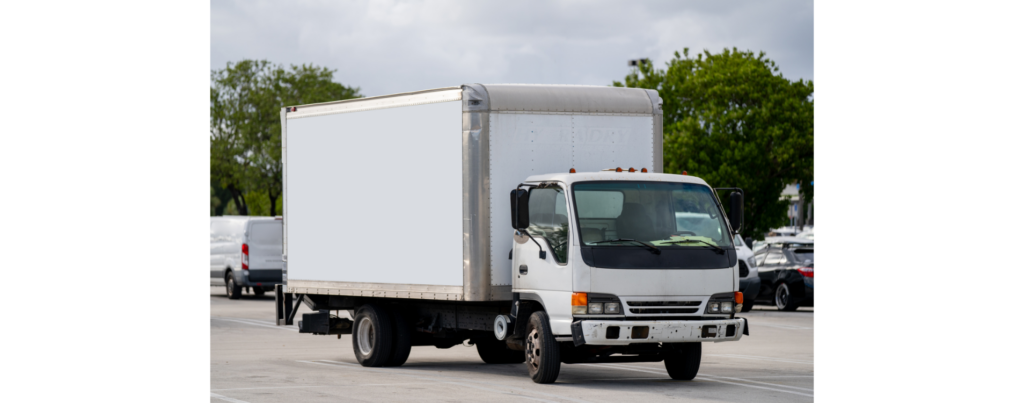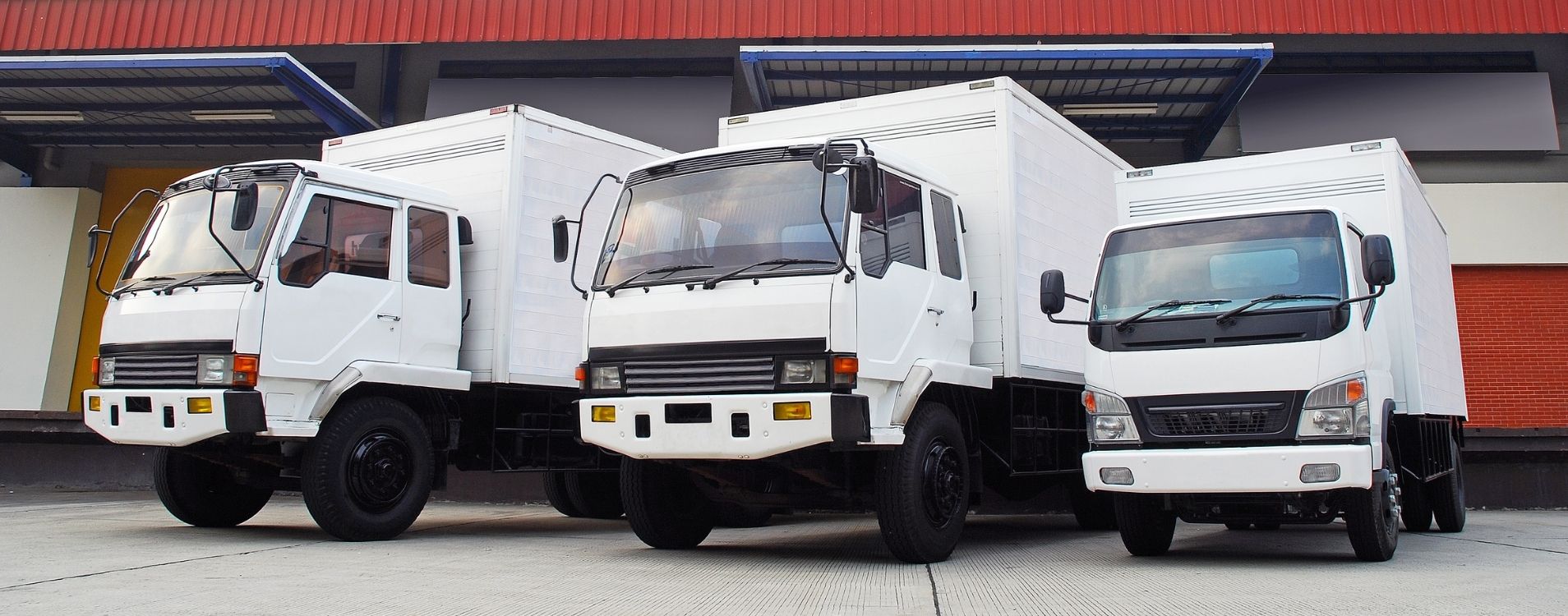How To Start A Box Truck Business In 5 Steps
Not all truck drivers need a big rig. With the continuing boom in e-commerce, there’s a near-limitless market for smaller deliveries—the kinds of loads you can easily handle with a box truck.
What is a box truck?
A box truck is a vehicle with a cuboid storage area attached to the chassis; it is one piece, not a power unit with a trailer.

Within the Federal Highway Administration’s truck classification system, most box trucks are considered medium duty, ranging from Class 3 (10,001 pounds to 14,000 pounds of gross vehicle weight) to Class 6 (19,501 pounds to 26,000 pounds). Larger box trucks may fall under the heavy-duty range, up to Class 7 (26,001 pounds to 33,000 pounds).
These trucks find a middle ground between storage capacity and the ability to navigate urban roads. While last-mile delivery services may opt for the smaller sprinter vans, box trucks are equally adept at moving cargo within local boundaries and between them.
Why start a box truck business?
A box truck business has a lower barrier to entry than jumping into a semi-truck, mostly because driving a box truck does not usually require a commercial driver’s license (CDL). That allows you to start hauling freight—and getting paid—without the lengthy (and costly) process of obtaining your CDL.
Whether you plan to launch a whole fleet, work as an owner-operator, or just set up a weekend side hustle, here’s how to start a box truck business in five simple steps.
Steps for starting your box truck business
1. Start your business on paper.
From the government’s perspective, you can’t start a box truck business until it’s registered. Here are some of the business-creation tasks to complete as you start your box truck business:
Choose a legal structure.
You will need to register your business in the state where you are based. If you’re driving on your own, you can organize as a sole proprietorship, however, we recommend trucking businesses establish an LLC or corporation to protect your personal assets. Also, if you plan to grow a fleet, you might be better off incorporating your business.
Find your state’s registration office with the SBA’s tool.
Related article: What’s The Best Legal Structure For A New Trucking Business?
File for an Employer Identification Number (EIN).
This is your federal tax ID, something like a social security number for the business. Apply for your EIN through the IRS online portal, or do some preliminary research with the U.S. Small Business Association (SBA).
Related article: How To Get An EIN For Your Trucking Company
Sign up with the FMCSA.
If you plan to run the operation across state lines using your own operating authority, you will need to sign up for a DOT and MC number with the FMCSA.
Use the FMCA’s tool to determine whether you need the DOT number or not.
There’s a $300 fee to get your authority; learn more and find links to register for an MC number at the FMCSA’s website. To activate an operating authority with the FMCSA, you’ll need insurance and a BOC-3 filing.
Related article: How To Get A USDOT Number And Operating Authority For Your New Trucking Company
Quick tip for intrastate carriers: If you’re planning to operate only within your home state, you may need a motor carrier authority from your state government as well. Check with your local Secretary of State or DMV office for more information.
Establish your driver qualification file.
The Federal Motor Carrier Safety Administration (FMCSA) requires carriers to maintain records showing that drivers are qualified to operate on the roads—even if you’re an owner-operator, and even if you don’t have a CDL. That means even box truck drivers need a qualification file.
Here’s a checklist of the documents to collect in this file; start with the section marked “Initial DQ File Documents.” Note that this file does require an application for employment, even if you’re your own employer.
Related article: Requirements For Driver Qualification Files (DQ File)
2. Set up a business checking account.
Once your business is established, it’s crucial to keep your personal finances separate from the business’. That requires, at the very least, a business checking account.
It’s also a good idea to get a business credit card. Building credit as a business is critical because it can help you access lower rates on equipment loans and make other financial services more accessible.
Related article: How To Open A Bank Account For Your Trucking Company
For more advice on managing cash flow in the box truck industry, see number five on this list.
3. Acquire your box truck, insurance, and related equipment.
If you’re not sitting on tens of thousands of dollars to buy a box truck outright, don’t fret. You can still start a box truck business. In fact, many drivers begin by renting trucks for occasional work. Commercial truck rental services like Penske, Ryder, and Enterprise allow you to rent a box truck without as much upfront capital as leasing or buying.
Renting is expensive, of course—you’ll typically pay a rental fee plus a per-mile rate. To hold onto more of your revenue, consider leasing a truck. This option is more capital-intensive; you’ll probably need a deposit of around $5,000 to sign a leasing agreement. But leases are more cost-effective, over time, than renting.
The third option is to buy your own box truck. New box trucks run anywhere from $15,000 to $120,000 and up—even more if you opt for a refrigerated cargo area. That means you’ll probably need financing, either from the dealer, a bank, or an SBA program. (Learn more about financing commercial trucks in our article about low down-payment semi trucks; a lot of the advice applies to box trucks, too.)
These three options—renting, leasing, and buying a box truck—can complement each other. You could start a carrier gig job by renting a box truck on the weekends. Once you build a bit of capital from your box truck business, you can get a leasing agreement. After your business earns enough for a down payment, you can buy your own box truck.
You’ll also need insurance, of course. Insurers like Progressive, Freeway, and Safeline provide insurance for commercial box trucks—your rental or leasing company may be able to help, too.
Related article: A Guide To Shopping For Commercial Trucking Insurance
Finally, consider the material handling equipment you might need to move loads in and out of your truck. If you move pallet loads, invest in a pallet jack, for instance, and be sure to stock your truck with plenty of straps or other load-securing equipment.
4. Find work.
Once your business is ready to go, you just need one thing: customers. This is the most challenging part of starting a trucking business after your paperwork sorted.
Luckily for you, we have a guide for new carriers on how to book loads. You can download it here.
Start with a load board, an online marketplace for freight and carriers. Examples include Landstar (free, with premium services available at a cost) and DAT (subscription-based). These load boards allow you to filter work by type, so you can easily find box truck work. Amazon Relay is a load board just for Amazon logistics and can provide lots of opportunities for box truck carriers.
Another option is to use a spot freight feature on an electronic logging device (ELD). These ELDs are digital systems that ensure compliance with the FMCSA’s hours-of-service rules, which regulate work and break hours for truck drivers. Many box truck drivers aren’t required to use ELDs; the hours-of-service regulations include an exception for short-haul, local driving.
But many ELD providers offer add-on freight-spotting services; the system knows where your truck is located, and can match you with work on the spot. A service like this turns a carrier into something like an Uber driver. Simply turn on the app and start hauling.
Side note: how to get contracts for a box truck
It is possible to get long-term stable work with a box truck. While this might not pay as much as a spot rate, it can give your business more long-term benefits. Here are some strategies to get contracts:
- Use load boards: load boards lead to brokers and, if you play your cards right, that can lead to fruitful, long-term relationships.
- Contact freight brokers directly: if you already know some brokers, ask them outright if they have contracts for box trucks.
- Amazon Relay: to sign up with Amazon, you need DOT and MC numbers, be authorized for hire, and have a good safety rating.
- Try local matching sites: look into GoShare, Lugg, and Dolly.
- Government contracts: this is a particularly good option for minority-owned businesses, though you’ll need to get your MBE certification first.
5. Maintain steady cash flow to grow (or maintain) your box truck business.
A box truck business has constant expenses. You have to buy fuel. You have to pay rental or leasing fees, or make payments on a truck loan. Insurance bills arrive every month. In short, a successful box truck business requires steady, reliable cash flow to keep going—and even if you have plenty of work, cash flow can become a challenge in this industry.
That’s because shippers and brokers may not pay immediately. A lot of them operate on net-30 terms, meaning they have 30 days to pay your invoice. Some run net-60 terms. The promise of money tomorrow doesn’t help when you have an empty gas tank today.
The solution is a financial tool called factoring. Factoring companies like Bobtail pay your invoices today, collecting on them from your customers. They collect a percentage of the invoice value for this service, but it’s often well worth the price—especially when it’s as low as ours.
Bobtail is a factoring service designed to streamline financing, with low factoring rates (1.99% to 3.25%, depending on the size of your business) and no hidden fees. You don’t have to sign a contract with us. Just open the app, enter your load information, and get funded the same day—or, if it’s after 11 a.m., the next day. It’s a powerful tool for a brand-new box truck company.
Knowing how to start a box truck business is just the first step. Next, it’s time to get to work—and if you need help with cash flow as your box truck business grows, contact us to learn more about our factoring service.




